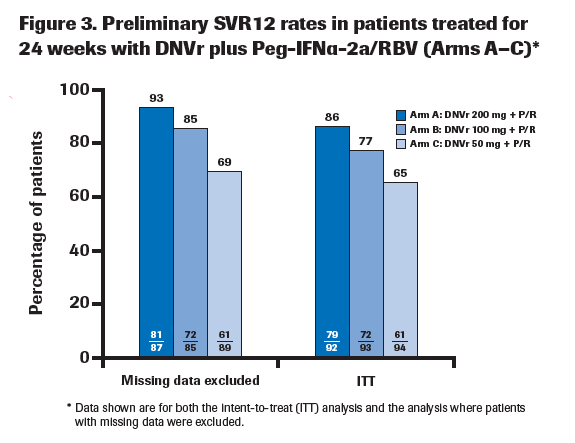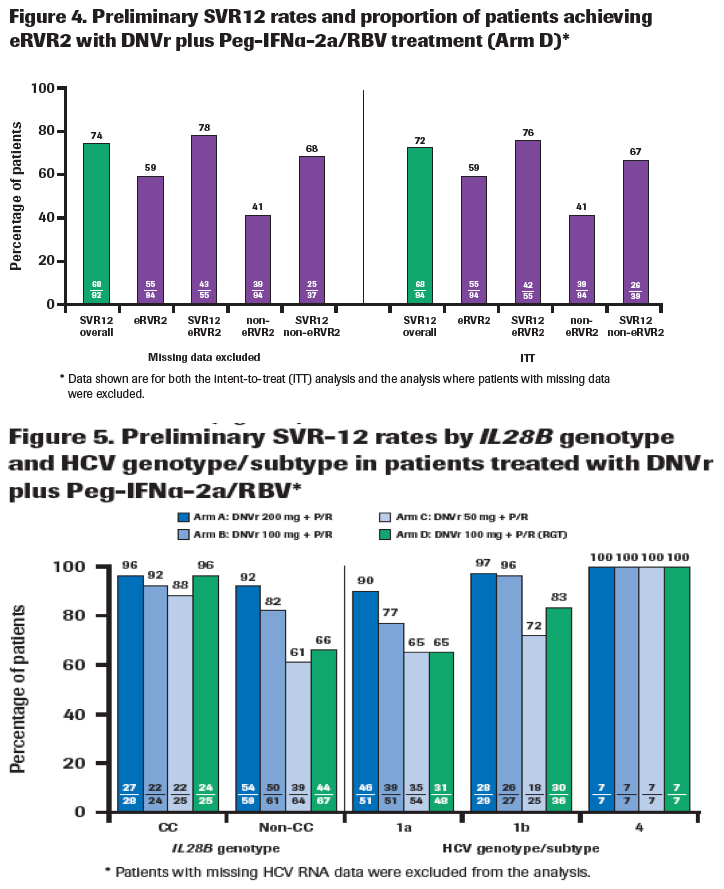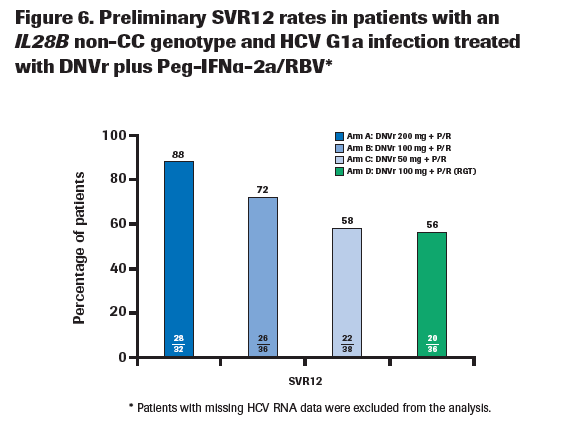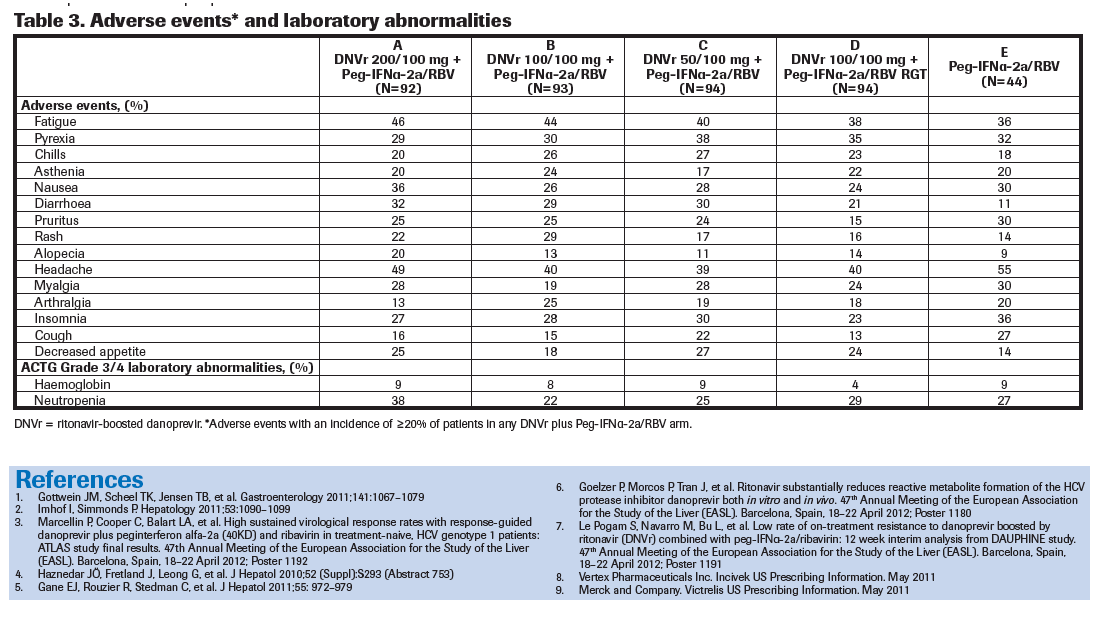 |
 |
 |
| |
RAPID AND SUSTAINED ACHIEVEMENT OF UNDETECTABLE HCV RNA DURING TREATMENT WITH RITONAVIR-BOOSTED
DANOPREVIR/PEG-IFNα-2A/RBV IN HCV GENOTYPE 1 OR 4 PATIENTS: DAUPHINE WEEK 36 INTERIM ANALYSIS
|
| |
| |
Reported by Jules Levin
EASL 2012 Apr 18-22 Barcelona Spain
G. Everson,1 C. Cooper,2 C. Hézode,3 M.L. Shiffman,4 E. Yoshida,5 T. Beltran-Jaramillo,6 P. Ferenci,7 S. Zeuzem,8 M. Brunda,9 N. Shulman,10 M.T. Navarro,10 A. Voulgari,11 S. Le Pogam,9 I. Najera,9 E.S. Yetzer10
1University of Colorado School of Medicine, Denver, CO, USA; 2The Ottawa Hospital, Ottawa, ON, Canada; 3University Paris XII, Hôpital Henri Mondor, Creteil Cedex, France; 4Liver Institute of Virginia, Richmond and Newport News, VA, USA; 5University of British Columbia, Vancouver, BC, Canada; 6Asesor del departamento de Inmunoanálisis, Médico especialista en Medicina Interna, Mexico; 7Medical University of Vienna, Vienna, Austria; 8J.W. Goethe University Hospital, Frankfurt, Germany; 9Roche, Nutley, NJ, USA; 10Genentech, South San Francisco, CA, USA; 11Roche, Welwyn, United Kingdom
CONCLUSIONS
· Overall, SVR12 rates of 93%, 85% and 69% were achieved with DNVr 200/100 mg, 100/100 mg and 50/100 mg, respectively, in treatment-naive
HCV G1/4-infected patients.
· High (90%) SVR12 rates were achieved with DNVr 200/100 mg in patients with the hardest-to-treat HCV G1a infection.
· SVR12 rates of >92% were observed with both DNVr 200/100 mg and 100/100 mg (24 weeks) in HCV G1b-infected patients and in patients with an
IL28B CC genotype.
· All DNVr-treated HCV G4-infected patients achieved an SVR12, independent of DNVr dose or treatment duration.
· Treatment with DNVr in combination with Peg-IFNα-2a/RBV was generally well tolerated, with no dose-dependent increases in AEs, and no DNVr-related
Grade 3/4 ALT elevations or increased treatment discontinuations observed during DNVr treatment.
For analyses where patients with missing data were excluded.

INTRODUCTION
· Danoprevir (DNV; RG7227)
- Potent, macrocyclic, HCV protease inhibitor
- Equipotent activity against HCV genotypes 1, 4 and 6 in vitro.[1,2]
· ATLAS (unboosted DNV)
- Explored response-guided therapy with DNV (300 mg q8h, 600 mg q12h and 900 mg q12h) plus Peg-IFNα-2a (40KD)/RBV for 12 weeks followed by
Peg-IFNα-2a/RBV for a total of 24 or 48 weeks[3]
- SVR rates were as high as 85% (see poster 1192)[3]
- The 900 mg DNV arm was discontinued early due to three cases of reversible Grade 4 ALT elevations in that arm.[3]
· Ritonavir boosting (co-administration of ritonavir 100 mg) of DNV
- Allows lower dosing (50-200 mg) of DNV[4,5]
- Enables higher Cmin levels with lower patient exposure to DNV[4,5]
- Maintains potent antiviral activity of DNV[4,5]
- Inhibits DNV reactive metabolite formation, which may eliminate the risk of ALT elevations (see poster 1180).[6]
· Here, we report the interim week 36 efficacy (SVR12 in DNV arms) and safety analyses from an ongoing phase IIb study (DAUPHINE) evaluating ritonavir-boosted DNV (DNVr) in combination with Peg-IFNα-2a (40KD)/RBV in treatment-naive patients with HCV genotype (G) 1 or 4 infection.
OBJECTIVES
· To evaluate the efficacy, safety and tolerability of DNVr in combination with Peg-IFNα-2a/RBV for 12 or 24 weeks versus Peg-IFNα-2a/RBV in treatment-naive patients with HCV G1 or 4 infection.
METHODS
Study design
· DAUPHINE is an ongoing, multicentre, randomised, open-label, active-controlled phase IIb study.
· Eligible patients were treatment-naive, chronic HCV G1 or 4-infected adults (≥18 years of age), with a serum HCV RNA level ≥50,000 IU/mL and F0-2 fibrosis.
Treatment
· Patients were randomised 2:2:2:2:1 to receive DNVr 200 mg/100 mg q12h (A), 100 mg/100 mg q12h (B), or 50 mg/100 mg q12h (C) for 24 weeks or 100 mg/100 mgq12h for 12/24 weeks (D; response-guided therapy [RGT]), in combination with Peg-IFNα-2a 180 μg/week plus RBV 1,000 mg (body weight <75 kg)/1,200 mg
(≥75 kg) daily in two divided doses; or Peg-IFNα-2a 180 μg/week plus RBV 1,000/1,200 mg for 48 weeks (E) (Figure 1).
· Patients in the RGT Arm D stopped all treatments at week 12 if they achieved an early extended rapid virologic response (eRVR2; HCV RNA <15 IU/mL throughout weeks 2-10), or continued to week 24 if they did not achieve eRVR2.
· In the control Arm E, patients without a complete early virologic response (cEVR; HCV RNA <15 IU/mL at week 12) either discontinued treatment or could elect to receive rollover treatment with DNVr and Peg-IFNα-2a/RBV (excluding null responders).
Analyses
· HCV RNA quantification: Roche COBAS® TaqMan® HCV Test (lower limit of detection = 15 IU/mL).
· Viral resistance monitoring: nucleotide sequence and phenotypic analyses.
· Efficacy analyses: 20 patients (five, eight, five and two patients in Arms A, B, C and D, respectively) who had undetectable HCV RNA (<15 IU/mL) at their last visit did not have SVR12 data, including 10 patients who had off-treatment data. Data are presented as:
-- "Missing data excluded" analysis - patients with missing data were not included
-- "Intent-to-treat (ITT)" analysis - patients with missing data were considered non-responders.
· Safety.
60% GT1a, 70% non-CC40% F2

Efficacy
Preliminary SVR12 rates in DNVr Arms A-C
· Arm E patients had not completed the full 48 weeks of Peg-IFNα-2a/RBV treatment at the time of this interim analysis.
· Overall, SVR12 rates increased with increasing dose of DNVr, with 93% of patients achieving an SVR12 with the highest DNVr dose regimen
(200/100 mg) (patients with missing data excluded) (Figure 3).


Preliminary SVR12 rates in the response-guided therapy DNVr Arm D
· An overall SVR12 rate of 74% was achieved with response-guided DNVr therapy, with the majority (59%) of patients eligible to receive a shortened
duration of treatment of 12 weeks (Figure 4).
· Among patients who achieved an eRVR2 in the DNVr 100/100 mg RGT arm, the SVR12 rate was 78% (43/55) with 12 weeks of treatment compared with
68% (25/37) in non-eRVR2 patients with 24 weeks of treatment (Figure 4).
Preliminary SVR12 rates by IL28B
genotype and HCV genotype/subtype
· Across DNVr treatment arms, SVR12 rates tended to be higher in patients with an IL28B CC compared with IL28B non-CC genotype and in patients with HCV G1b
compared with HCV G1a infection (Figure 5).
· The 200/100 mg q12h and 100/100 mg q12h doses of DNVr demonstrated comparable SVR12 rates in patients with an IL28B CC genotype, or HCV G1b or G4 infection (Figure 5).
· Among patients randomised to the highest DNVr dose regimen (200/100 mg q12h), SVR12 rates were consistently high (90-100%), irrespective of host IL28B
genotype (CC, non-CC) and viral genotype/subtype (1a, 1b, 4) (Figure 5).
· All HCV G4-infected patients treated with DNVr plus Peg-IFNα-2a/RBV achieved an SVR12 (N=7 patients/arm) (Figure 5).
· In the DNVr 200/100 mg arm, the difficult-to-treat IL28B non-CC genotype/HCV G1a subpopulation achieved an SVR12 rate of 88% (Figure 6).




|
| |
|
 |
 |
|
|